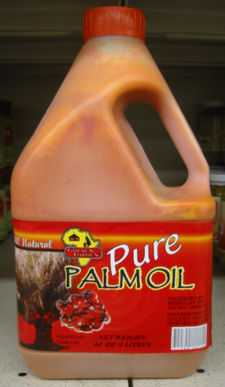Palm oil
2007 Schools Wikipedia Selection. Related subjects: Food and agriculture
Palm oil is a form of edible vegetable oil obtained from the fruit of the oil palm tree. It is the second-most widely produced edible oil, after soybean oil. However, it may have now surpassed soybean oil as the most widely produced vegetable oil in the world.
The palm fruit is the source of both palm oil (extracted from palm fruit) and palm kernel oil (extracted from the fruit seeds).
Palm oil itself is reddish because it contains a high amount of betacarotene. It is used as cooking oil, to make margarine and is a component of many processed foods. Boiling it a few minutes destroys the carotenoids and the oil becomes white.
Palm oil is one of the few vegetable oils relatively high in saturated fats (such as coconut oil) and thus semi-solid at room temperature.
History
Palm oil was long known of in West African states, and amongst West African peoples, saw widespread use as a cooking oil. European merchants trading with West Africa occasionally purchased palm oil for use in Europe, but as the oil was bulky and cheap, and due to the much higher profits available from slave-trading, palm oil remained rare outside West Africa. During the early nineteenth century, the decline of the Atlantic slave trade and Europe's demand for legitimate commerce (trade in material goods rather than human lives) obliged African states to seek new sources of trade revenue. In the Asante Confederacy, state-owned slaves built large plantations of oil palm trees, while in the neighbouring Kingdom of Dahomey, King Ghezo passed a law in 1856 forbidding his subjects from cutting down oil palms. Palm oil became a highly sought-after commodity by British traders, the oil being used as industrial lubricant for the machines of Britain's ongoing Industrial Revolution, as well as forming the basis for soaps such as Palmolive. By c.1870, palm oil constituted the primary export of West Africa. By the 1880's, cocoa became more highly sought-after, leading to the decline of the palm oil trade.
Chemical composition
The palm oil and palm kernel oil are composed of fatty acids, esterified with glycerol just like any ordinary fat. Both are high in saturated fatty acids, about 50% resp 80%. The oil palm gives its name to the 16 carbon saturated fatty acid palmitic acid found in palm oil; monounsaturated oleic acid is also a constituent of palm oil while palm kernel oil contains mainly lauric acid. Palm oil is the largest natural source of tocotrienol, part of the vitamin E family. Palm oil is also high in vitamin K and dietary magnesium.
Napalm derives its name from naphthenic acid, palmitic acid and pyrotechnics or simply from a recipe using naphtha and palm oil.
The proximate concentration of fatty acids (FAs) in palm oil is as follows: :
- Saturated (total : 49.9%)
- Palmitic C16:0 44.3%
- Stearic C18:0 4.6%
- Myristic C14:0 1.0%
- Monounsaturated
- Oleic C18:1 38.7%
- Polyunsaturated
- Linoleic C18:2 10.5%
For palm kernel oil the fatty acid content is :
- Saturated (total : 82%)
- Lauric C12:0 48.2%
- Myristic C14:0 16.2%
- Palmitic C16:0 8.4%
- Capric C10:0 3.4%
- Caprylic C8:0 3.3%
- Stearic C18:0 2.5%
- Mononsaturated
- Oleic C18:1 15.3%
- Polyunsaturated
- Linoleic C18:2 2.3%
Nutrition
Its high caloric value means that the palm nut is eaten by a wide variety of animals, including, rather improbably, two birds of prey, the Palm Nut Vulture and the Harrier Hawk.
Saturated fat, found in palm oil and palm kernal oil but also in coconut oil, beef fat, and milk fat is correlated with an increased risk of atherosclerosis and coronary heart disease.
Unrefined palm and coconut oils do not increase the risk of atherosclerosis.
Environmental and cultural impact
Demand for palm oil is rising and is expected to climb further, particularly for use in biodiesel. Biodiesel is promoted as a form of renewable energy that greatly reduces net emissions of carbon dioxide into the atmosphere, and therefore its use is being touted as a way to decrease the impact of the greenhouse effect and also the possibility of peak oil.
However, there is increasing concern from environmental and other NGOs about the social and environmental impacts of the palm oil industry. It is said that rainforests are being cleared to make room for the plantations, thus reducing the habitat for some threatened species, such as the orangutan (on Borneo and Sumatra). The plantations are often run by agribusiness, and locals in places such as West Papua and Kalimantan are missing out on jobs to migrant workers. However most of the rainforest is actually cleared for tropical wood production, sometimes illegal. There is far more forest cleared that ever necessary for palm oil production.
Orangutan experts around the world have unified to recognise that continued development of the palm oil sector, if done unsustainably, is the single greatest threat to the future of orangutans in the wild. The best professional estimates state that if the industry is not regulated then within 12 years we may witness the disappearance of orangutans from the wild. Other species that are critically threatened by disappearance of the forests include the Sumatran tiger and rhinoceros.
Palm Oil as Biodiesel
The Malaysian government is refocusing the use of palm oil to the production of biodiesel to cater to the huge demand from European countries; it has encouraged the building of biodiesel plants. This is due to the higher prices of fuel and increasing demand for alternative sources of energy in the Western world.
The plants will start operating middle of next year and produce 100,000 tonnes of biodiesel annually. Strong demand for biodiesel from Europe as well as Colombia, India, South Korea and Turkey has fueled the industry's growth as more countries seek to reduce their reliance on fossil fuels.
Malaysia has already begun preparations to change from diesel to bio-fuels by 2008, including drafting legislation that will make the switch mandatory. From 2007, all diesel sold in Malaysia must contain 5% palm oil. Being the world's largest producer of crude palm oil, Malaysia intends to take advantage of the rush to find cleaner fuels.
With the growing emphasis on biodiesels presenting a sustainable alternative to fossil fuels it is important to recognise that these benefits are partly negated when forest is cleared to make room for biodiesel crops such as oil palm. NGOs are now alerting the international arena to the fact that despite millions of hectares of land standing unplanted in Indonesia there is still clearance of tropical hardwood forest for palm oil plantations. Furthermore, as the remaining unprotected lowland forest dwindles, developers are looking to peat swamp for conversion, which causes a draining of the peat, which not only unlocks the carbon in the surface covering of trees, but begins an oxidation process of the carbon in the peat reserve--which can be between 5,000 to 10,000 years worth of carbon locked into the ground. Drained peat is also at very high risk of forest fire, and there is a clear record of fire being used to clear vegetation for palm oil development in Indonesia.
Health
Among the touted health benefits of palm oil, most notably red palm oil, are:
- Rich in betacarotenes, especially red palm oil.
Crude palm oil is considered the richest natural source of carotenoids (about 15 times more than in carrots). Carotenoids are a group of more than 700 compounds (e.g. alpha-carotene, beta-carotene) that produce the red, yellow, and orange colours found in many fruits and vegetables. The human body uses carotenoids as Vitamin A which enhances eye health. Carotenoids also play an important potential role by acting as biological antioxidants, protecting cells and tissues from the damaging effect of free radicals, which could cause cancer. Studies also suggest that carotenoids enhance immune function by a variety of mechanisms, and improve cardiovascular health. Red palm oil is a form of processed palm oil (deacidified and deodorised) which retains 80% of the original carotenoids, making it a remarkable source of Vitamin A.
- High in tocotrienols, an antioxidant with other possible health benefits
Natural vitamin E exists in eight different forms or isomers, four tocopherols and four tocotrienols. Natural palm oil contains alpha, beta, gamma, and delta-tocopherols and alpha, beta, gamma, and delta-tocotrienols. No other natural source contains this much vitamin E (though the only form of vitamin E active in the human body is alpha-tocopherol). Tocotrienols in Vitamin E have been found to have many beneficial properties, among them antioxidant and anti-cancer activities. Probably the most important finding in recent research on tocotrienol was its role in inhibiting human breast cancer cells. Tocotrienols have also been demonstrated to lower blood cholesterol levels, by reacting with certain enzymes in the liver which produces cholesterol. Its antioxidant properties bring many benefits to the human body, such as preventing skin aging, preventing fat oxidation, reducing blood pressure and many more.
- Other minor nutrients
Palm oil contained about 10% linoleic acid, which is an unsaturated omega-6 fatty acid. Linoleic acid is one of the two essential fatty acids that humans require. Palm oil also contains small amounts of squalene (possible cholesterol lowering and anti-cancer properties) and ubiquinone (energy booster).
- Red palm oil is rich in co-enzyme Q10
Reasons for choosing palm oil:
- Palm oil is an excellent dietary energy source.
- Palm oil is a very rich source of Vitamin A and E.
- Palm oil is a stable oil in high temperatures (good for frying).
- Palm oil is a cheap vegetable oil (due to the oil palm's high productivity).
Palm oil and blood cholesterol controversy
For many years now, it has been established that the primary cholesterol-elevating fatty acids are the saturated fatty acids with 12 ( lauric acid), 14 ( myristic acid) and 16 ( palmitic acid) carbon atoms with a concomitant increase in the risk of coronary heart disease. Monounsaturated fatty acids such as oleic acid is as effective in reducing serum total and low-density lipoprotein (LDL) cholesterol levels as polyunsaturated fatty acids such as alpha-linoleic acid. The World Health Organization in its report states there is convincing evidence that palmitic oil consumption contributes to an increased risk of developing of cardiovascular diseases.
A study by a group of researchers in China comparing palm, soybean, peanut oils and lard showed that palm oil actually increased the levels of good cholesterol and reduced the levels of bad cholesterol in the blood (Zhang, et al, 1995, 1997 cited by Koh, 2006).
A study by Hornstra in 1990 also showed similar results.
Social and environmental palm oil links
- Orangutan Film Protection Project
- Roundtable on Sustainable Palm Oil
- Friends of the Earth
- Website from the author of The Oil for Ape Scandal
- Palm Oil page from the Borneo Orangutan Survival Foundation
- PalmOil.com - Palm Oil Prices, Palm Oil Market Reports, Companies & Palm Oil Industry Information
Other palm oil links
- Palm Oil Education, Companies and Industry Information
- Malaysian Palm Oil Council
- Palm Oil - Production, Consumption, Exports, and Imports Statistics by Country
- American Palm Oil Council
- Malaysian palm oil board
- Physical properties of palm oil
- Colombian website (Fedepalma) on palm oil
- Roundtable on Sustainable Palmoil


